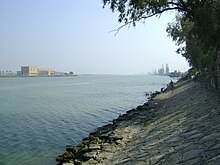Arvand Rud
| Shatt al-Arab | |
|---|---|

|
|
| Other name(s) | Arvand Rud |
| Country | Iraq, Iran |
| Basin features | |
| Main source |
Tigris–Euphrates confluence at Al-Qurnah and Karun River in Iran 4 m (13 ft) |
| River mouth |
Persian Gulf 0 m (0 ft) |
| Physical characteristics | |
| Length | 200 km (120 mi) |
| Discharge |
|
Shatt al-Arab (شط العرب "River of the Arabs" in Arabic countries) or Arvand Rud (Persian: اَروَندرود, "Swift River" in Persian speaking countries) is a river in Basra Governorate of some 200 km (120 mi) in length, formed by the confluence of the Euphrates and the Tigris in the town of al-Qurnah in the Basra Governorate of southern Iraq. The southern end of the river constitutes the border between Iraq and Iran down to the mouth of the river as it discharges into the Persian Gulf. The river is geopolitically significant because it forms a natural border between Iran and the Arab world (Iraq). It varies in width from about 232 metres (761 ft) at Basra to 800 metres (2,600 ft) at its mouth. It is thought that the waterway formed relatively recently in geologic time, with the Tigris and Euphrates originally emptying into the Persian Gulf via a channel further to the west.
The Karun river, a tributary which joins the waterway from the Iranian side, deposits large amounts of silt into the river; this necessitates continuous dredging to keep it navigable.
The area is judged to hold the largest date palm forest in the world. In the mid-1970s, the region included 17 to 18 million date palms, an estimated one-fifth of the world's 90 million palm trees. But by 2002, war, salt, and pests had wiped out more than 14 million of the palms, including around 9 million in Iraq and 5 million in Iran. Many of the remaining 3 to 4 million trees are in poor condition.
In Middle Persian literature and the Shahnama (written between c. 977 and 1010 AD), the name اروند Arvand is used for the Tigris, the confluent of the Shatt al-Arab.Iranians also used this name specifically to designate the Shatt al-Arab during the later Pahlavi period, and continue to do so after the Iranian Revolution of 1979.
...
Wikipedia
